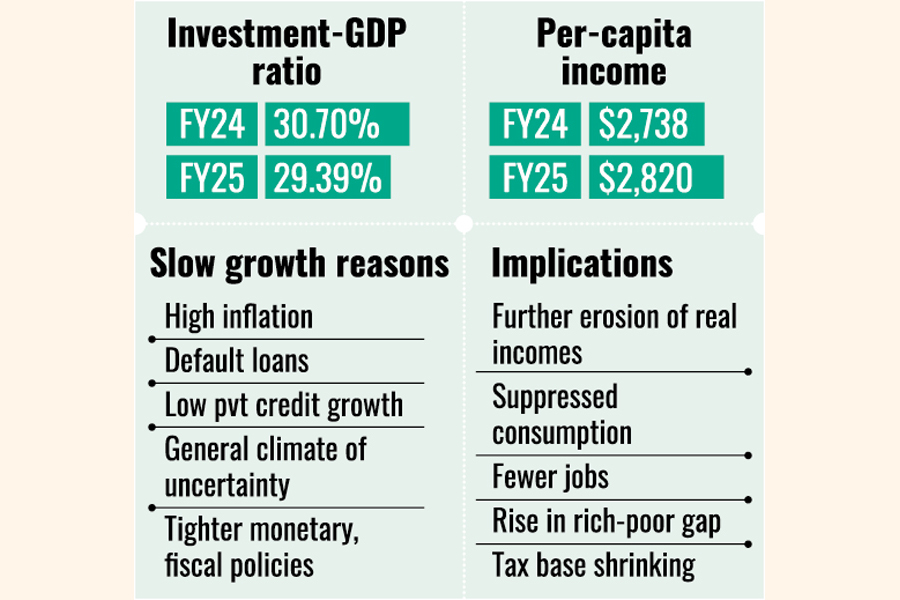Bangladesh’s economy has faced a significant slowdown in the current fiscal year, with the three big sectors – agriculture, industry, and services – recording slower growth, official data showed on Tuesday.
The FY25 gross domestic product (GDP) growth was recorded at 3.97 per cent, the lowest since the coronavirus-impacted FY20, provisional data from the Bangladesh Bureau of Statistics (BBS) revealed.
The key sectors grew at modest rates – agriculture by 1.79 per cent, industry by 4.34 per cent, and services by 4.51 per cent.
While these figures reflect some economic activities, they fall far short of the government’s initial ambitious GDP-growth target of 6.75 per cent and even the revised target of 5.25 per cent for the current fiscal year.
Although GDP expanded at a slower rate, per capita income rose to $2,820 in the current fiscal year from $2,738 in FY24.
The lower GDP growth aligns with earlier projections made by international bodies. The International Monetary Fund (IMF) forecast 3.76 per cent, the Asian Development Bank (ADB) 3.9 per cent, and the World Bank (WB) 3.3 per cent for FY25.
The trio cited persistent economic challenges as reasons for lower projections.
Though the GDP growth slowed down to 3.45 per cent in FY20 during the Covid-19 pandemic, it rebounded the following year with an expansion rate of 6.94 per cent, which further rose to 7.10 per cent in FY22.
Then the growth started slowing, reaching 5.78 per cent in FY23 and going down further to 4.22 per cent in FY24, the BBS data shows.
Bangladesh’s encouraging industrial sector growth is still in the slower trajectory as it recorded a massive slowdown in the ongoing fiscal year, like the past.
Growth in this sector was estimated a little bit better at 4.34 per cent compared to 3.51 per cent in the last fiscal year.
Meanwhile, both the service and agriculture sectors grew at lower rates than FY24.
The service sector expanded at 4.51 per cent in FY25, down from 5.09 per cent in the previous fiscal year.
On the other hand, the agriculture sector grew at only 1.79 per cent compared to 3.30 per cent in FY24.
Meanwhile, the investment-GDP ratio in FY25 was recorded at 29.39 per cent, down from 30.70 per cent in the last fiscal year.
The FY25 GDP size was estimated at Tk 55.527 trillion ($462 billion).
The lower FY25 GDP growth has raised concerns among economists and policymakers. Economists and various reports have pinpointed several interconnected factors contributing to this situation.
Inflation has remained stubbornly high, eroding the purchasing power of households and dampening domestic demand. The IMF expects inflation to hover around 10 per cent in FY25, further straining household budgets.
Historically, low tax revenues have put significant strains on public finances, limiting the government’s ability to stimulate the economy through public spending.
The banking sector continues to face major challenges, particularly with a large share of default loans (around 35 per cent). This constrains the flow of credit to the private sector, hindering investment and economic activities.
Moreover, a general climate of uncertainty, coupled with tighter monetary and fiscal policies, has dampened investment sentiment. This is evident in the slower growth of private sector credit.
Reports from various institutions, including the World Bank, have highlighted that political turmoil and instability in the earlier periods of FY25 weighed on economic activities and investors’ confidence.
Disruptions in supply chains and import restrictions have weakened industrial activities and contributed to price pressures.
The government’s decision to reduce allocations for large-scale development projects has also led to the slowdown.
The lower GDP growth is expected to have significant implications. Experts warn that sluggish growth will further erode real incomes and suppress consumption, particularly among low-income groups, potentially pushing more people into extreme poverty.
Slow growth translates into fewer employment opportunities, a major concern considering the country’s youth unemployment rate.
Besides, the gap between the rich and the poor could rise further. Lower economic activities will shrink the tax base, impacting government revenue collection and subsequently affecting social sectors like health and education.
While the immediate outlook presents significant headwinds, both the IMF and the ADB foresee a gradual recovery in Bangladesh’s economic trajectory over the medium term.
For FY26, the IMF has forecast 6.53 per cent growth, while the ADB has projected 5.1 per cent.
However, sustaining high growth momentum will necessitate bold reforms, particularly in improving revenue collection, addressing banking sector vulnerabilities, and fostering a conducive investment climate.
The government’s focus on fiscal discipline and containing inflation will be crucial for navigating these challenges.
kabirhumayan10@gmail.com

